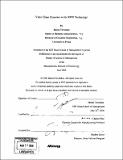| dc.contributor.advisor | Charles Fine. | en_US |
| dc.contributor.author | Tavshikar, Milind (Milind Murlidhar) | en_US |
| dc.contributor.other | Sloan School of Management. | en_US |
| dc.date.accessioned | 2007-04-20T15:57:26Z | |
| dc.date.available | 2007-04-20T15:57:26Z | |
| dc.date.copyright | 2006 | en_US |
| dc.date.issued | 2006 | en_US |
| dc.identifier.uri | http://hdl.handle.net/1721.1/37256 | |
| dc.description | Thesis (S.M.)--Massachusetts Institute of Technology, Sloan School of Management, 2006. | en_US |
| dc.description | Includes bibliographical references (leaf 66). | en_US |
| dc.description.abstract | RFID (Radio Frequency Identification) technology has been one of the oldest renewed technologies with a promise of becoming a foundation of "The Internet of Things" in future. MIT's Auto-ID labs and EPCGlobal have been instrumental in advocating standards, making mass scale adoption a reality. The early adopters were found to be in the retail supply chain industry followed by many interesting applications in areas ranging from Fish Tracking to authentication of currency notes. Projects implemented till 2006 were mainly pilot in nature with a desire to understand the technology, given its limitations and challenges and conclude with value propositions or return on investment analysis for corporations. This work has attempted to study such phenomenon in greater detail, bring together the dimensions of technology and business as related to the current state of RFID. We found a very different set of value dynamics applicable to each individual component in the RFID business landscape. Analysis on presented in more detail for manufacturers (Suppliers) of goods as well as Sellers (Retailers) of goods. Further work may be in the form of analyzing the remaining components like logistics players and end customers in a similar fashion. | en_US |
| dc.description.abstract | (cont.) Case studies and interview were done to collect data. Secondary sources of information in the forms of published reports and articles are also used and referenced. Management science techniques like Systems Dynamics are used to model some of the value parameters for each component in the retail supply chain. In conclusion, we think although each component of the studied landscape has shown value enhancement and erosion (primarily to cost factors), the overall system shows net gains. As all other technologies, RFID will become cheaper with increased adoption and has a very high probability to be prevalent and ubiquitous in near future. | en_US |
| dc.description.statementofresponsibility | by Milind Tavshikar. | en_US |
| dc.format.extent | 66 leaves | en_US |
| dc.language.iso | eng | en_US |
| dc.publisher | Massachusetts Institute of Technology | en_US |
| dc.rights | M.I.T. theses are protected by copyright. They may be viewed from this source for any purpose, but reproduction or distribution in any format is prohibited without written permission. See provided URL for inquiries about permission. | en_US |
| dc.rights.uri | http://dspace.mit.edu/handle/1721.1/7582 | |
| dc.subject | Sloan School of Management. | en_US |
| dc.title | Value chain dynamics in the RFID technology | en_US |
| dc.type | Thesis | en_US |
| dc.description.degree | S.M. | en_US |
| dc.contributor.department | Sloan School of Management | |
| dc.identifier.oclc | 85838314 | en_US |
